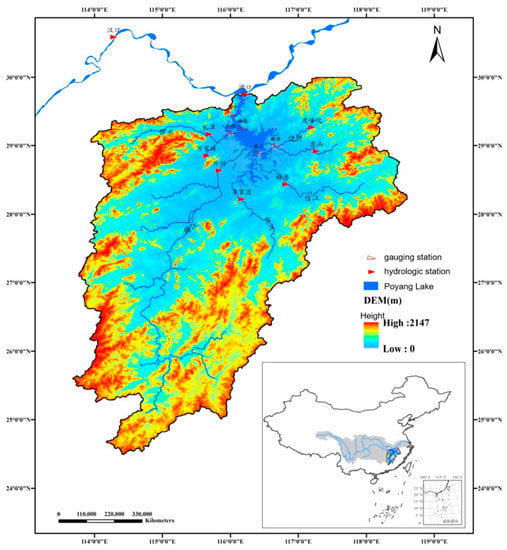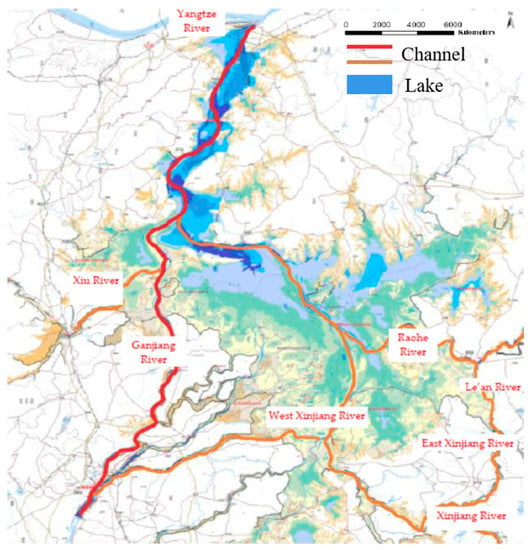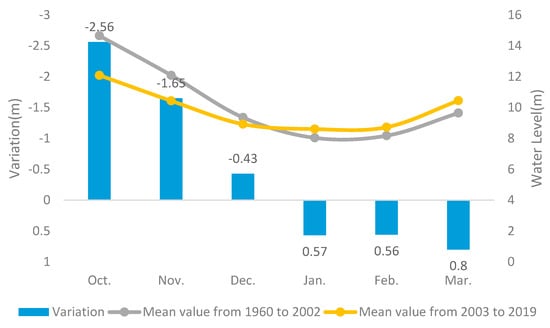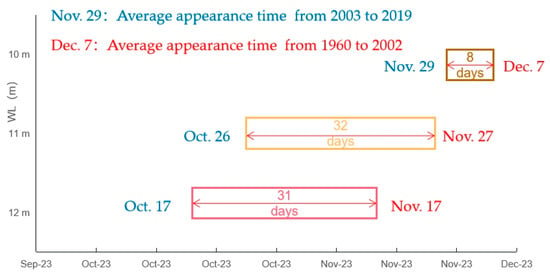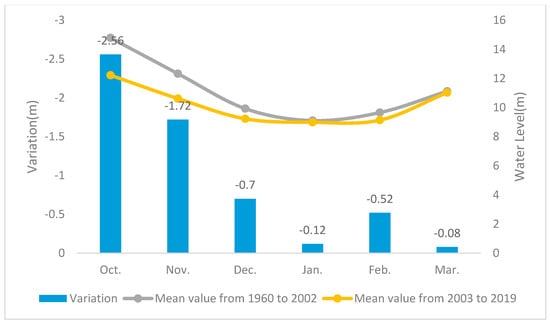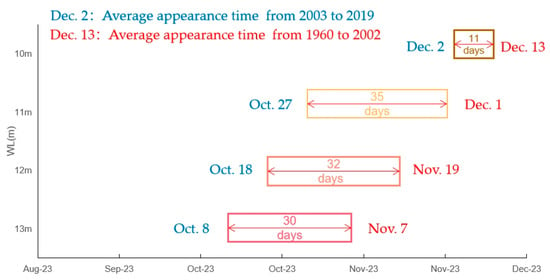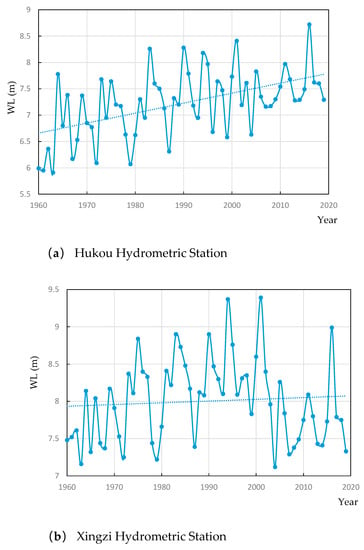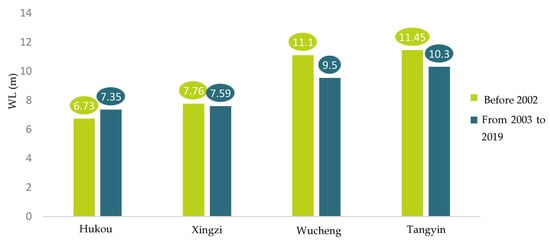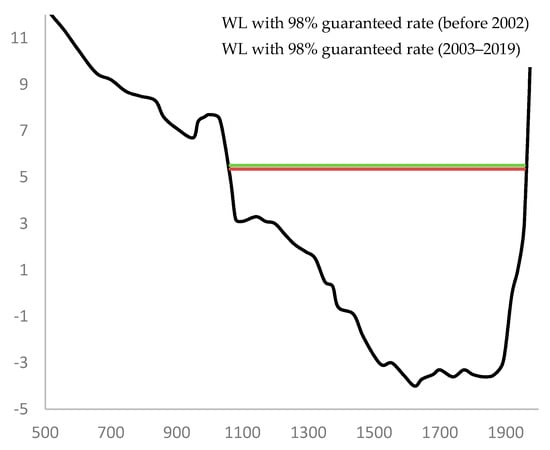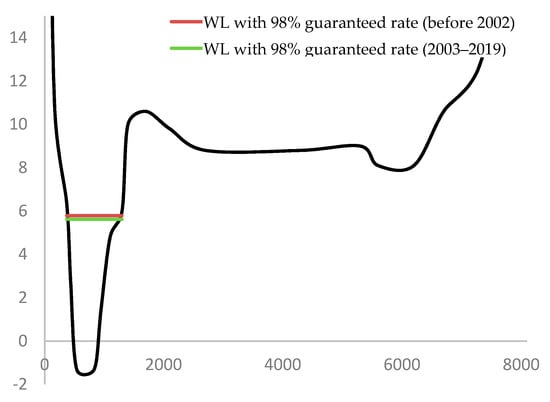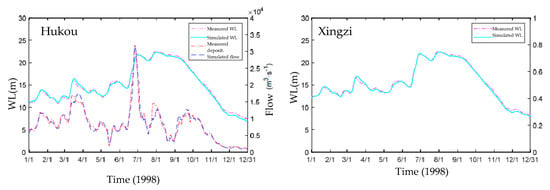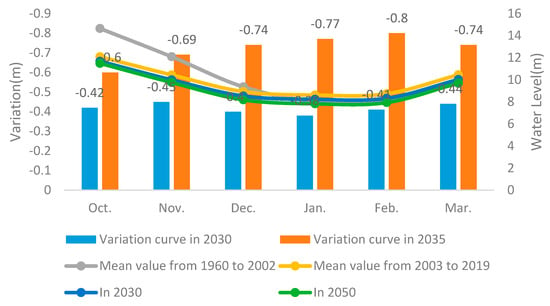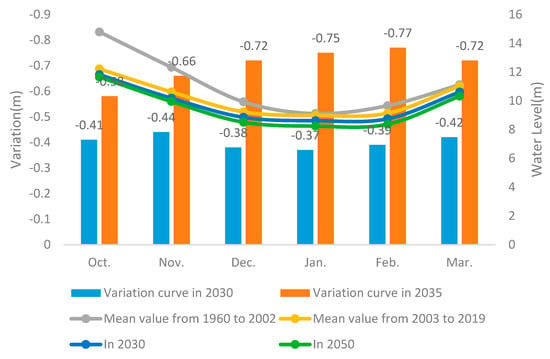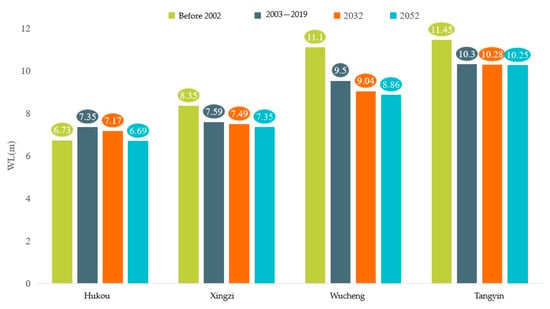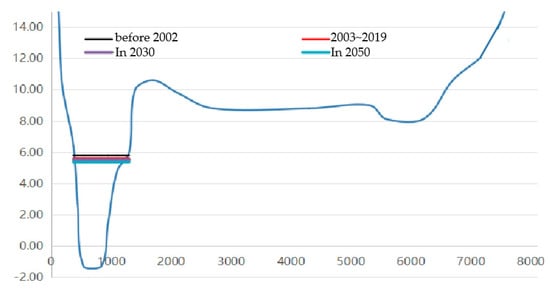Abstract
Human activities have profoundly changed the hydrological regime and trends of rivers and lakes, which, in turn, has affected the utilization of their navigable conditions. However, few studies have focused on the effects of changes in hydrological regimes and trends of rivers and lakes on navigable conditions. Thus, this study intensively analyzes and investigates the navigable depth at the major control sections in the lake area during the dry season in the period before 2002, when the Three Gorges Reservoir was not yet constructed, and the period from 2003 to 2019, when the Three Gorges Project was put into operation with impoundment based on the dry-season water level curve in the Poyang Lake area since the operation of the Three Gorges Reservoir. This study also further analyzes the influence of the change in the hydrological regime on the navigable depth in the lake area. The results show that the waterway depth and width could meet the navigation requirements before 2002. From 2003 to 2019, whereas the water level with a 98% guarantee rate of duration at the Xingzi Hydrometric Station decreased, that at the Hukou Hydrometric Station increased. The waterway depth and width at both the Hukou and Xingzi hydrometric stations could meet the requirements of the size of Grade II waterways. This study also performs a simulation prediction of the water regime of Poyang Lake under a new hydrological regime using the mathematical model of water and sediment of the Changjiang River Scientific Research Institute. The results reveal that in 2030 and 2050, after the Three Gorges Reservoir has been in operation for 30–50 years, the water levels at the Hukou, Xingzi, and Wucheng hydrometric stations (Hukou) of Poyang Lake will decline by approximately 0.18–0.66 and 0.10–0.24 m, respectively. Although the overall navigable depth can basically meet the navigation requirements for a period of time, the trend of the long-term declining water level may cause unsafe navigation risks.
1. Introduction
In recent years, the concept of the river–lake relationship has become increasingly involved in the study of water and sediment exchange between Poyang Lake and Yangtze River [1]. Accordingly, the influence of the change in the river–lake relationship caused by the Three Gorges Project (located 1063 km upstream of Poyang Lake) on Dongting and Poyang lakes in the middle reaches of the Yangtze River has been given increasing attention by academic circles [2,3,4]. Yangtze River and Poyang Lake join at the Hukou Hydrometric Station (Figure 1), constituting an intricate river–lake relationship, in which the lake water discharges into the river, or the river water flows back into the lake. The water exchange between rivers and lakes is affected by the water from the five rivers in the upper reaches of Poyang Lake and that from the Yangtze River. This enables Poyang Lake to regulate and store the flood water in the Yangtze River and leads to the river evolution and lake erosion–deposition and change in the hydrological regime, as well as the effects of the water resources, environment, and ecology and shipping arising thereof due to the flow and mass energy exchange between Yangtze River and Poyang Lake [5,6].
1.1. The Impact of Human Activities on River-Lake Relations
The water regime of the main stream of the Yangtze River directly affects the interaction between the Yangtze River and the Poyang Lake [7,8]. Hu et al. performed a quantitative analysis of the state, intensity, and annual variation characteristics of the water exchange between rivers and lakes using various parameters (e.g., the net change rate of the lake flow) and analyzed the influence of the river–lake relationship on the water level of Poyang Lake from 1960 to 2003. The results show that the water coming from the Poyang Lake basin plays a leading role in Poyang Lake’s water level and flood disaster, whereas the backwater of the Yangtze River plays a secondary role in Poyang Lake. Zhang et al. [9] showed that since 1990, the occurrence frequency of Yangtze River inpouring into Poyang Lake has significantly decreased and has an intermittent feature, which is in good correspondence with the temporal variation of rainfall. The analysis of the inflow and outflow water and sediment regime in Poyang Lake shows that the runoff at the Wuhe and Hukou hydrometric stations of Poyang Lake since 2003 was less than that before 2000. Moreover, the sediment discharge into the lake at the Wuhe hydrometric station significantly decreased, whereas the average annual sediment discharge at the Hukou hydrometric station markedly increased [10,11]. Natural factors, such as the significant decrease of the sediment in Poyang Lake, climate change, tectonic subsidence, soil erosion, sediment deposition, and Yangtze River regime change, led to a change in the river–lake relationship, but human activities since the 20th century have accelerated the adjustment of this relationship [12,13,14].
Before the flood season, the reservoir will increase the discharge to reserve flood control storage capacity. After the flood season, the reservoir will reduce the discharge to save water. Thus, the water regime of Poyang Lake significantly changed [15,16,17], especially before the flood season and at the end of this season. Zhang et al. [18] used a generalized additive model to simulate and verify that the impoundment operation of the Three Gorges Project caused a 5% average loss of the inflow from the Yangtze River, and that the impoundment period at the end of the flood season slowed down the backwater effect of Yangtze River on Poyang Lake, thereby aggravating the drought in Poyang Lake in autumn. Liu et al. [19] used multitemporal satellite remote sensing data from 1973 to 2011 to collect the water surface information of Poyang Lake based on its water balance analysis. The results showed that the change in the river–lake relationship between the Yangtze River and Poyang Lake caused by the impoundment operation of the Three Gorges Project is one of the main control factors of the sudden change of the water level at the end of the flood season in Poyang Lake in recent years.
The impoundment operation of the Three Gorges Project reduced the main stream discharge under the dam during the flood season and increased it under the dam during the dry season, leading to a silt discharge decrease in the Yangtze River. The change of the water regime in the main stream of the middle reaches of the Yangtze River changed the interaction between the Yangtze River and the two lakes [20,21,22,23]. Human activities and climate change have dramatically changed the evolution process and trend of the hydrology and geomorphology of rivers and lakes. With the completion and operation of reservoirs in the upper and middle reaches of the Yangtze River, the relationship between the rivers and lakes in the middle and lower reaches of the river underwent dramatic changes, which affected the utilization of its navigable depth. The change in the river–lake relationship is an important factor affecting the hydrological and sediment environments of Poyang Lake, which has a bearing on the safety of shipping in the lake area. Based on the analysis of the navigability and characteristics of the navigation-obstructing shoals in the Raohe Lake area, Yang [24] employed mathematical models to calculate the key parameters of the dredging depth of the navigation channels in each shoal section of the lake waterway. He also analyzed the change in the hydrodynamic conditions and the velocity variations at the channel section after the project.
1.2. The Impact of Hydrological Regime Changing on Navigability of the Yangtze River
The navigability of the Yangtze River supports the economic and social developments along it. By 2020, the water volume of the Yangtze River was 30.6 × 108 t, accounting for 78.6% of the total water volume in China’s inland rivers [24]. Affected by sand mining in the lake area and the operation of the upstream Three Gorges Reservoir, the hydrological regime of the two lakes changed, and the change of the hydrological regime in the lake area may bring about some adverse effects on the navigability of the two lakes in the future [25,26,27,28]. However, existing studies paid little attention to the influence of the river–lake relationship and the change of the hydrological regime in the river–lake intersection area [29], especially in terms of the development and utilization of deep-water resources in the main channel of the Yangtze River. The correct understanding and adequate regulation of the change of the river–lake relationship are keys to realizing safe navigation in the rivers and lakes in the Poyang Lake area [30,31,32,33]. With the change in the relationship between the hydrological regime and the rivers and lakes in the main stream of the Yangtze River, defects, such as insufficient consistency and sequence length of data, were found in the existing hydrological observation data, making it difficult to ensure safe navigation in Poyang Lake under the new hydrological regime. The existing research often ignores the influence of the Three Gorges Reservoir on the hydrological regime. As a result, the simulation results are far from the actual situation. To solve the abovementioned problems, this study simulates and predicts the navigable depth in the Poyang Lake area based on the water level curve analysis of Poyang Lake since the operation of the Three Gorges Reservoir by analyzing the hydrological regime and the water level curve and simulating and predicting the navigation safety of Poyang Lake.
2. Overview of the Study Area
The Poyang Lake water system is a convergent water system, with Poyang Lake as its convergence center. It is composed of the Ganjiang, Fuhe, Xinjiang, Raohe, and Xiushui rivers and other rivers directly flowing into Poyang Lake from the area around it. The Poyang Lake basin is high in the south and low in the north. The basin is surrounded by mountains and gradually slopes towards Poyang Lake on all sides, forming a basin-like terrain with Poyang Lake as the bottom. The water from all the rivers that gather in Poyang Lake is stored in Hukou, Jiangxi Province, before being discharged into the Yangtze River. The Poyang Lake basin is located on the right bank of the middle and lower reaches of the Yangtze River, covering an area of 162,200 km2 and accounting for approximately 9% of the Yangtze River basin area. The Poyang Lake is densely covered with rivers and lakes. Its navigation involves the five water systems of the Ganjiang, Fuhe, Xinjiang, Raohe, and Xiuhe rivers. The water from these five rivers comes from the confluence of the Chuxi Estuary 20 km downstream of Wucheng and flows into the Yangtze River via Xingzi. Poyang Lake has 99 navigable rivers or routes and 5 major water system basins with a navigable mileage of 5525 km, including 310 km of grade III and above waterways. The Grade III waterways in the lake area were required to be (2.0~2.4 m) × (90~110 m) × 550 m. The Ganjiang and Xinjiang River waterways are the main waterways in the lake area. Ganjiang River is also the major water transport artery in Jiangxi. Figure 2 depicts a schematic diagram of the main waterways in the Poyang Lake area.
3. Water Level Curve Analysis in the Poyang Lake Area during the Dry Season since the Operation of the Three Gorges Reservoir
In this section, the water level curves in the lake area before and after the construction of the Three Gorges Reservoir were compared and analyzed using the observation data collected from the Xingzi hydrometric station, which was selected as the lake stage gauging station, and the Hukou hydrometric station, which was chosen as the outlet gauging station, in the Poyang Lake area before (from 1960 to 2002) and after (from 2003 to 2019) the Three Gorges Reservoir operation.
3.1. Mean Water Level Variation in the Poyang Lake Area during the Dry Season (from September to October) since the Operation of the Three Gorges Reservoir
Since the operation of the Three Gorges Reservoir, the monthly average water level of all the stations in the lake area generally showed a downward trend from October to March, except for the Hukou hydrometric station, where the monthly average water level showed a downward trend from January to March. The specific analysis of the water levels at the Hukou and Xingzi hydrometric stations is described below.
3.1.1. Analysis and Discussion of Water Level Variation at Hukou Hydrometric Station
After 2003, the average water level at the Hukou hydrometric station decreased from October to December and increased from January to March. Compared with that for the period from 1960 to 2002, the average water level from 2003 to 2019 decreased by 2.56, 1.65, and 0.43 m in October, November, and December, respectively, and increased by 0.57, 0.56, and 0.80 m in January, February, and March, respectively. The water level in the dry season also came earlier than usual. According to statistics, the 12, 11, and 10 m water levels were advanced by approximately 31, 32, and 8 days, respectively. Consequently, the deep-water channel in the middle flood period in the lake area became the dry season channel. Moreover, the duration of the deep-water channel in the mid-flood period was reduced by approximately 8%. The vessels operating in the lake area can travel with a full load in the mid-flood period, whereas in the dry season, the load of goods is generally reduced to ensure safe navigation. Therefore, the advanced occurrence of the dry season in the lake area inhibited the development of merchant shipping to some extent.
Figure 3 shows the water level variation at the Hukou Hydrometric Station during the dry season. Figure 4 presents the analysis results of the early occurrence of the low water level in the dry season. After the operation of the Three Gorges Project, the variation of the water level at Hukou Station in the dry season showed obvious seasonal characteristics. Affected by the flood control operation of the Three Gorges Reservoir, the water level of Hukou Station decreased from October to December and increased from January to March. At the same time, the average occurrence time of the low water level (11 m, 12 m) at Hukou Station was significantly advanced. However, the average occurrence time of the extremely low water level (10 m) at Hukou Station had little change due to the minimum discharge requirements of the Three Gorges Reservoir.
Figure 3.
Water level variation and water level curve of the Hukou hydrometric station during the dry season.
3.1.2. Analysis and Discussion of Water Level Variation at Xingzi Hydrometric Station
After 2003, the average water level at the Xingzi hydrometric station decreased from October to March. Compared with that in the period from 1960 to 2002, the average water level in October, November, and December in 2003 and January, February, and March in 2019 decreased by 2.56, 1.72, 0.70, 0.12, 0.52, and 0.08 m, respectively. The water level at Hukou increased from January to March due to the influence of water replenishment during the dry season of the upper reaches of the Three Gorges Reservoir and other reservoirs. At the Xingzi reach, the water replenishment effect of the upstream reservoir was insignificant. The water level of the Xingzi reach in the dry season also showed a downward trend overall due to the influence of sand mining and river regulation measures. Moreover, the water level in the dry season came earlier than usual. Statistics revealed that the 13, 12, 11, and 10 m water levels were advanced by approximately 30, 32, 35, and 11 days, respectively.
Figure 5 illustrates the water level variation at the Xingzi hydrometric station in the dry season. Figure 6 shows the analysis results of the early occurrence of the water level in the dry season. After the operation of the Three Gorges Project, the variation of the water level at Hukou Station in the dry season showed obvious seasonal characteristics. Affected by the flood control operation of the Three Gorges Reservoir, the average water level of Xingzi Station significantly decreased from October to December, and slightly from January to March. Meanwhile, the average occurrence time of the low water level (13, 11, 12 m) at Xingzi Station was significantly advanced. However, under the influence of the minimum discharge requirements of the Three Gorges Reservoir, the average occurrence time of the extremely low water level (10 m) at Xingzi Station had little change.
Figure 5.
Monthly variation of the average water level at the Xingzi hydrometric station during the dry season (unit: m).
3.2. Variation of the Annual Lowest Water Level in the Lake Area since the Operation of the Three Gorges Project
Figure 7 displays the annual lowest water level at the Hukou and Xingzi hydrometric stations from 1960 to 2019. The annual lowest water level at the Hukou hydrometric station showed a slight upward trend, whereas that at the Xingzi and Poyang hydrometric stations depicted no obvious change. The main reason for these results is that the Three Gorges Reservoir increased the water supply to the middle and lower reaches of the Yangtze River during the dry period, resulting in the rise of the annual lowest water level at the Hukou hydrometric station.
6. Conclusions and Discussion
Since the operation of the Three Gorges Reservoir, the water level at Hukou had been rising from January to March due to the influence of the water replenishment during the dry season of the upper reaches of the Three Gorges and other reservoirs. The Xingzi reach was not affected by the water replenishment of the upstream reservoir, and its water level showed a downward trend in the dry season. The minimum water level of Hukou Station and Xingzi Station in the dry season appeared 8~31 days earlier than that before the Three Gorges was used. The dry water level of Poyang Lake usually occurs from December to February. After the operation of the Three Gorges Project, the water level of the main stream increased due to the replenishment of the upstream reservoir in the dry period. However, it had a limited effect on the lake area and the lake water level increase was not obvious. Therefore, since the operation of the Three Gorges, the navigation safety problems in the lake area are mainly concentrated from December to February of the next year.
The calculation results showed that the hydrological regime variation has a certain impact on the navigable depths of the waterway in the lake area. Moreover, the waterway depth and width could meet the navigation requirements before 2002. From 2003 to 2019, the navigable water level with a 98% guaranteed rate at Hukou increased, and the waterway depth and width met the requirements for the Grade II waterway dimensions. Although the navigable water level with a 98% guaranteed rate at the Xingzi hydrometric station decreased, the waterway depth and width still met the dimension requirements of Grade II channels. With the completion and operation of the upstream controlled reservoirs, the water level in the Poyang Lake area will continue to decline during the dry season. Furthermore, the water level with a 98% duration guarantee rate at each hydrometric station in the lake area will be reduced to the safe water level of the waterway. The navigable water depth of some river sections does not meet the requirements, adversely affecting navigation safety.
Author Contributions
This study was designed by D.W., and the first draft of the manuscript was written by T.Z. Then, the manuscript was organized, revised, and finally edited by T.Z. All authors have read and agreed to the published version of the manuscript.
Funding
This research was financially supported by the National Key Research and Development Program of China: Study on simultaneous wet or dry years in the Yangtze River and the Yellow River under changing environment and water allocation in extreme dry years (No. 2022YFC3202300).
Institutional Review Board Statement
Not applicable.
Informed Consent Statement
Not applicable.
Data Availability Statement
No new data were created or analyzed in this study. Data sharing is not applicable to this article.
Conflicts of Interest
The authors declare no conflict of interest.
References
- Hu, Q.; Feng, S.; Guo, H.; Chen, G.; Jiang, T. Interactions of the Yangtze river flow and hydrologic processes of the Poyang Lake, China. J. Hydrol. 2007, 347, 90–100. [Google Scholar] [CrossRef]
- Li, M.; Li, Y. On the Hydrodynamic Behavior of the Changed River–Lake Relationship in a Large Floodplain System, Poyang Lake (China). Water 2020, 12, 626. [Google Scholar] [CrossRef]
- Wang, H.; Zhong, H.; Lu, J.; Yan, Q.; Li, S.; Zhou, Y. Understanding the River-Lake Relationship after the Operation of TGR based on SWAT Model. J. Coast. Res. 2020, 104, 593–600. [Google Scholar] [CrossRef]
- Gao, K.C. Analysis of the Characteristics of Discharged Sediment in Yangtze River Estuary. Appl. Mech. Mater. 2014, 501, 2049–2055. [Google Scholar] [CrossRef]
- Watanabe, T.N. Role of flood storage ability of lakes in the Changjiang River catchment. Glob. Planet. Change 2008, 63, 9–22. [Google Scholar]
- Ming, Z.H.; Xiaoxiang, F.E.; Zhe, L.I.; Weijuan, L.I. Impact on Dongting Lake channel caused by the change of flow and sediment environment after Three Gorges Project impoundment. Shuikexue Jinzhan/Adv. Water Sci. 2015, 26, 423–431. [Google Scholar]
- Xu, L.; Yuan, S.; Tang, H.; Qiu, J.; Xiao, Y.; Whittaker, C.; Gualtieri, C. Mixing Dynamics at the Large Confluence between the Yangtze River and Poyang Lake. Water Resour. Res. 2022, 58, e2022WR032195. [Google Scholar] [CrossRef]
- Guo, Y.; Lai, X.; Wu, X.; Chen, Y. Dry-Season Water Level Shift Induced by Channel Change of the River–Lake System in China’s Largest Freshwater Lake, Poyang Lake. Wetlands 2022, 42, 1–13. [Google Scholar] [CrossRef]
- Zhang, Q.; Liu, Y.; Yang, G.; Zhang, Z. Precipitation and hydrological variations and related associations with large-scale circulation in the Poyang Lake basin, China. Hydrol. Process. 2011, 25, 740–751. [Google Scholar] [CrossRef]
- Xu, K.; Milliman, J.D. Seasonal variations of sediment discharge from the Yangtze River before and after impoundment of the Three Gorges Dam. Geomorphology 2008, 104, 276–283. [Google Scholar] [CrossRef]
- Yuan, S.; Tang, H.; Li, K.; Xu, L.; Xiao, Y.; Gualtieri, C.; Rennie, C.; Melville, B. Hydrodynamics, Sediment Transport and Morphological Features at the Confluence Between the Yangtze River and the Poyang Lake. Water Resour. Res. 2021, 57, e2020WR028284. [Google Scholar] [CrossRef]
- Du, Y.; Xue, H.P.; Wu, S.J.; Ling, F.; Xiao, F.; Wei, X.H. Lake area changes in the middle Yangtze region of China over the 20th century. J. Environ. Manag. 2011, 92, 1248–1255. [Google Scholar] [CrossRef]
- Zhang, Z.; Jin, G.; Tang, H.; Zhang, S.; Zhu, D.; Xu, J. How does the three gorges dam affect the spatial and temporal variation of water levels in the Poyang Lake? J. Hydrol. 2022, 605, 127356. [Google Scholar] [CrossRef]
- Huang, S.; Xia, J.; Zeng, S.; Wang, Y.; She, D. Effect of Three Gorges Dam on Poyang Lake water level at daily scale based on machine learning. J. Geogr. Sci. 2021, 31, 1598–1614. [Google Scholar] [CrossRef]
- Zhu, L.; Xu, Q.; Dai, M. Runoff diverted from the Jingjiang reach to the Dongting Lake and the effect of Three Gorges Reservoir. Adv. Water Sci. 2016, 27, 822–831. [Google Scholar]
- Ou, C.; Li, J.; Zhou, Y.; Cheng, W.; Yang, Y.; Zhao, Z. Evolution characters of water exchange abilities between Dongting Lake and Yangtze River. J. Geogr. Sci. 2014, 24, 731–745. [Google Scholar] [CrossRef]
- Li, B.; Yang, G.; Wan, R.; Wang, Y.; Xu, C.; Wang, D.; Mi, C. Unraveling the Importance of the Yangtze River and Local Catchment on Water Level Variations of Poyang Lake (China) After the Three Gorges Dam Operation: Insights From Random Forest Modeling. Front. Earth Sci. 2022, 10, 927462. [Google Scholar] [CrossRef]
- Zhang, Q.; Li, L.; Wang, Y.G.; Werner, A.D.; Xin, P.; Jiang, T.; Barry, D.A. Has the Three-Gorges Dam made the Poyang Lake wetlands wetter and drier? Geophys. Res. Lett. 2012, 39. Available online: https://agupubs.onlinelibrary.wiley.com/doi/full/10.1029/2012GL053431 (accessed on 18 December 2022). [CrossRef]
- Liu, Y.; Wu, G.; Zhao, X. Recent declines in China’s largest freshwater lake: Trend or regime shift? Environ. Res. Lett. 2013, 8, 014010. [Google Scholar] [CrossRef]
- Dai, S.B.; Yang, S.L.; Zhu, J.; Gao, A.; Li, P. The role of Lake Dongting in regulating the sediment budget of the Yangtze River. Hydrol. Earth Syst. Sci. 2005, 9, 692–698. [Google Scholar] [CrossRef]
- Dai, Z.; Du, J.; Li, J.; Li, W.; Chen, J. Runoff characteristics of the Changjiang River during 2006: Effect of extreme drought and the impounding of the Three Gorges Dam. Geophys. Res. Lett. 2008, 35, 521–539. [Google Scholar] [CrossRef]
- Yang, S.L.; Zhang, J.; Xu, X. Influence of the Three Gorges Dam on downstream delivery of sediment and its environmental implications, Yangtze River. Geophys. Res. Lett. 2007, 34. Available online: https://agupubs.onlinelibrary.wiley.com/doi/full/10.1029/2007GL029472 (accessed on 18 December 2022). [CrossRef]
- Chen, M.; Zeng, S.; Yang, L.; Tang, X.; Xia, J. Detailed attribution of long-term water exchange in the Yangtze-Poyang system at multiple time scales. J. Hydrol. 2022, 612, 128183. [Google Scholar] [CrossRef]
- Yang, Y.; Liu, W.; Zhang, J.; Yang, L.; Jia, M.; Zhu, L. Changes of Divergence and Confluence Relationship Between Dongting Lake and the Yangtze River After the Operation of the Three Gorges Project and Its Impact on the Waterway Depth. Front. Earth Sci. 2022, 10, 829669. [Google Scholar] [CrossRef]
- Xia, J.; Deng, S.; Lu, J.; Xu, Q.; Zong, Q.; Tan, G. Dynamic channel adjustments in the Jingjiang Reach of the Middle Yangtze River. Sci. Rep. 2016, 6, 22802. [Google Scholar] [CrossRef]
- Xia, J.; Zhou, M.; Lin, F.; Deng, S.; Lu, J. Variation in reach-scale bankfull discharge of the Jingjiang Reach undergoing upstream and downstream boundary controls. J. Hydrol. 2017, 547, 534–543. [Google Scholar] [CrossRef]
- Yang, Y.P.; Zhang, M.J.; Sun, Z.H.; Han, J.Q.; Wang, J.J. The relationship between water level change and river channel geometry adjustment in the downstream of the Three Gorges Dam. J. Geogr. Sci. 2018, 28, 1975–1993. [Google Scholar]
- Yang, Y.P.; Zhang, M.J.; Sun, Z.H.; Li, H.G.; Jiang, L.; Zhu, L.L.; Li, K.Y. Characteristics and Reason of Riverbed Evolution Difference in the Middle Yangtze River Based on River Unit Model. J. Basic Sci. Eng. 2018, 26, 70–84. [Google Scholar]
- Yang, Y.P.; Zhang, M.J.; Sun, Z.H.; Li, H.G.; Jiang, L.; Zhu, L.L.; Li, K.Y. Influence of the Three Gorges Dam on the transport and sorting of coarse and fine sediments downstream of the dam. J. Hydrol. 2022, 615, 128654. [Google Scholar] [CrossRef]
- Sun, Z.; Huang, Q.; Opp, C.; Hennig, T.; Marold, U. Impacts and Implications of Major Changes Caused by the Three Gorges Dam in the Middle Reaches of the Yangtze River, China. Water Resour. Manag. 2012, 26, 3367–3378. [Google Scholar] [CrossRef]
- Yang, Y.; Zhang, M.; Liu, W.; Wang, J.; Li, X. Relationship between Waterway Depth and Low-Flow Water Levels in Reaches below the Three Gorges Dam. J. Waterw. Port Coast. Ocean Eng. 2019, 145, 04018032. [Google Scholar] [CrossRef]
- Yang, Y.; Zhang, M.; Zhu, L.; Liu, W.; Han, J.; Yang, Y. Influence of Large Reservoir Operation on Water-Levels and Flows in Reaches below Dam: Case Study of the Three Gorges Reservoir. Sci. Rep. 2017, 7, 15640. [Google Scholar] [CrossRef]
- Yang, Y.; Yin, H.; Li, M.; Liu, W.; Li, K.; Yu, W. Effect of water depth and waterway obstructions on the divergence and confluence areas of Dongting Lake and the Yangtze River after the operation of the Three Gorges Project. River 2023. [Google Scholar] [CrossRef]
- Yaohua, D. Review and Prospect of CRSRI Mathematical Models of River Flow and Sediment Transport. J. Yangtze River Sci. Res. Inst. 2011, 28, 7–16. [Google Scholar]
Disclaimer/Publisher’s Note: The statements, opinions and data contained in all publications are solely those of the individual author(s) and contributor(s) and not of MDPI and/or the editor(s). MDPI and/or the editor(s) disclaim responsibility for any injury to people or property resulting from any ideas, methods, instructions or products referred to in the content. |
© 2023 by the authors. Licensee MDPI, Basel, Switzerland. This article is an open access article distributed under the terms and conditions of the Creative Commons Attribution (CC BY) license (https://creativecommons.org/licenses/by/4.0/).
